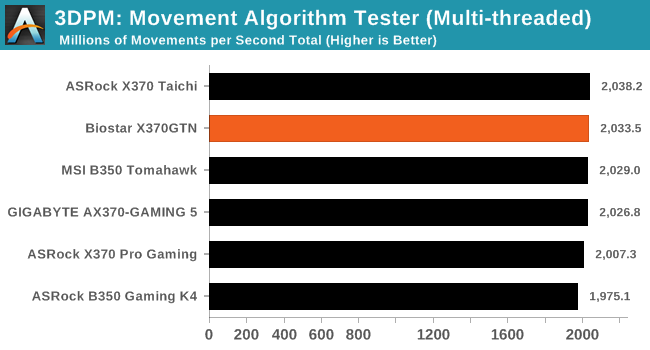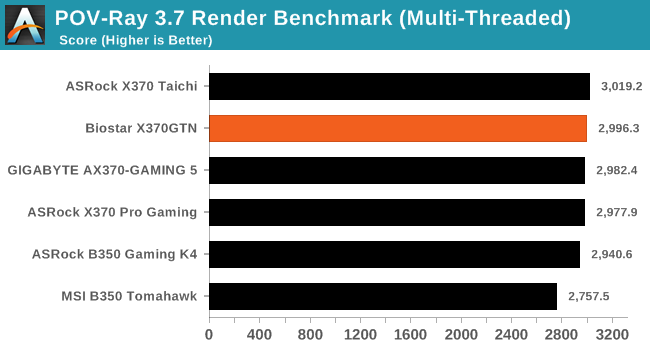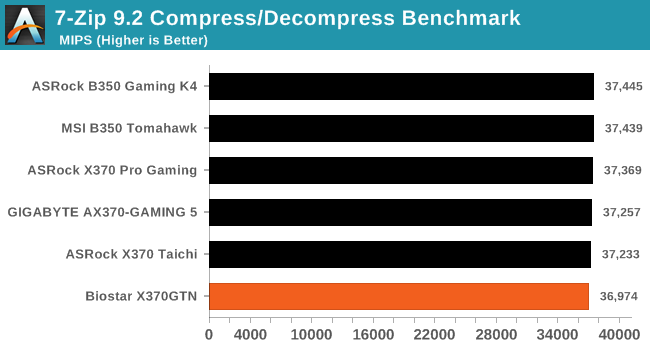The Biostar X370GTN Mini-ITX Motherboard Review: AM4 Goes Tiny
by Gavin Bonshor on October 23, 2017 9:00 AM ESTCPU Performance, Short Form
For our motherboard reviews, we use our short form testing method. These tests usually focus on if a motherboard is using MultiCore Turbo (the feature used to have maximum turbo on at all times, giving a frequency advantage), or if there are slight gains to be had from tweaking the firmware. We put the memory settings at the CPU manufacturers suggested frequency, making it very easy to see which motherboards have MCT enabled by default.
Video Conversion – Handbrake v1.0.2: link
Handbrake is a media conversion tool that was initially designed to help DVD ISOs and Video CDs into more common video formats. For HandBrake, we take two videos and convert them to x264 format in an MP4 container: a 2h20 640x266 DVD rip and a 10min double UHD 3840x4320 animation short. We also take the third video and transcode it to HEVC. Results are given in terms of the frames per second processed, and HandBrake uses as many threads as possible.



Compression – WinRAR 5.4: link
Our WinRAR test from 2013 is updated to the latest version of WinRAR at the start of 2017. We compress a set of 2867 files across 320 folders totaling 1.52 GB in size – 95% of these files are small typical website files, and the rest (90% of the size) are small 30 second 720p videos.

Point Calculations – 3D Movement Algorithm Test v2.1: link
3DPM is a self-penned benchmark, taking basic 3D movement algorithms used in Brownian Motion simulations and testing them for speed. High floating point performance, MHz and IPC wins in the single thread version, whereas the multithread version has to handle the threads and loves more cores. For a brief explanation of the platform agnostic coding behind this benchmark, see my forum post here. We are using the latest version of 3DPM, which has a significant number of tweaks over the original version to avoid issues with cache management and speeding up some of the algorithms.

Rendering – POV-Ray 3.7.1b4: link
The Persistence of Vision Ray Tracer, or POV-Ray, is a freeware package for as the name suggests, ray tracing. It is a pure renderer, rather than modeling software, but the latest beta version contains a handy benchmark for stressing all processing threads on a platform. We have been using this test in motherboard reviews to test memory stability at various CPU speeds to good effect – if it passes the test, the IMC in the CPU is stable for a given CPU speed. As a CPU test, it runs for approximately 2-3 minutes on high end platforms.

Synthetic – 7-Zip 9.2: link
As an open source compression tool, 7-Zip is a popular tool for making sets of files easier to handle and transfer. The software offers up its own benchmark, to which we report the result.

Neuron Simulation - DigiCortex v1.20: link
The newest benchmark in our suite is DigiCortex, a simulation of biologically plausible neural network circuits, and simulates activity of neurons and synapses. DigiCortex relies heavily on a mix of DRAM speed and computational throughput, indicating that systems which apply memory profiles properly should benefit and those that play fast and loose with overclocking settings might get some extra speed up. Results are taken during the steady state period in a 32k neuron simulation, and represented as a function of the ability to simulate in real time (1.000x equals real-time).










31 Comments
View All Comments
BrokenCrayons - Monday, October 23, 2017 - link
Yeah, right now some of the value is lost by the lack of iGPUs on AM4, but the video outs are there for the APU version of Zen. I don't know if such an APU is worth waiting around to get since HTPC and SFF office boxes are probably fine with currently available hardware. Biostar will at least have a mITX board available for when the new APUs come out.mikestefoy - Monday, October 23, 2017 - link
I wouldnt buy anything less than HDMI v2DanNeely - Monday, October 23, 2017 - link
True, but these boards are perfectly fine for people who want to build smaller single GPU boxes and know they don't need a 2nd PCIe card. The limitations of mITX have gotten small enough that using it instead of miniATX for a smaller build is an increasingly attractive option.Valantar - Monday, October 23, 2017 - link
"One perhaps disappointing omission from the BIOS is the inability to call upon XMP profiles from any installed memory."This is just plain wrong. I don't know if it's your BIOS, your board, or your RAM, but mine can load XMP profiles just fine, and has done that since long before AGESA 1.0.0.6. I'm not running Ryzen-optimized RAM, either, just some TridentZ 3200 sticks that I bought before Ryzen even launched. This warrants some further investigation, though. I can easily provide screenshots if you want.
twnznz - Tuesday, October 24, 2017 - link
There's just one issue I am having with this board. Every so often, the system will fail a boot, but then will short cycle power 5x before booting back into CMOS defaults.I think there's something not quite right with the BIOS.
Valantar - Tuesday, October 24, 2017 - link
I have the same issue, but from what I can tell it only happens when I run my RAM at 3200 (what it's rated for, XMP profile). At 3000 or below (same timings), it's never happened to me, at least.Oxford Guy - Thursday, October 26, 2017 - link
XMP profiles, as far as I know, are only optimized for Intel's controllers. AMD tends to not perform as well so it makes sense that you would need to lower RAM speed to use those timings.Rene23 - Sunday, October 29, 2017 - link
anyone knows if these AM4 mini-its boards POST and boot without VGA card? need this for a head-less Linux server only ;-)karan101 - Wednesday, November 1, 2017 - link
<p><a href="http://www.mechanicalworld.in ">mechanicalworld</a></p>Duracellmumus - Thursday, May 3, 2018 - link
Let me save this little puppy: i choose this board, because my case have a special desing and need to use a big tower-like cooler on cpu and this board designe was the only one what can i choose.The board arived whit 1.0.0.4b bios. Simply put together with 1800x and G.skill cl14 ram and boot up.
I set 1,35V to ram, reboot, set 3200Mhz and XMP reboot. From that time it run without any problem. Later I try all of the bios settings, and choose the best conbination for smooth gameplay. It takes 42 reboot to find it.
I do update to 1.0.0.6 next month. Its able to set up manualy the memory timings, it way beter than leave the XMP on and the timeing "auto".
There is no any issue whit this x370GTN Biostar board.